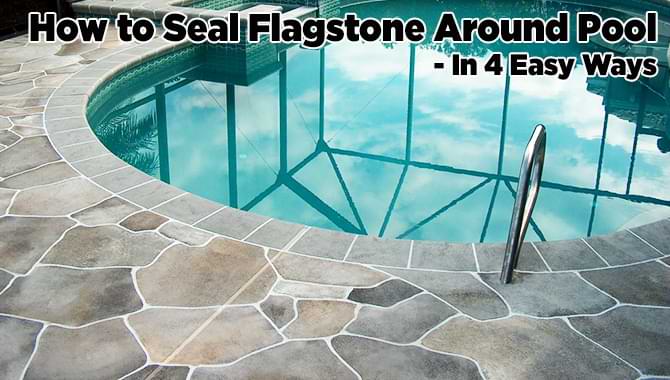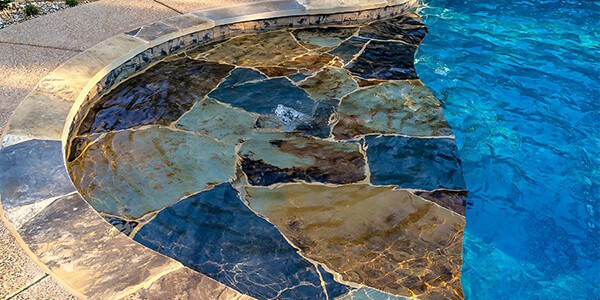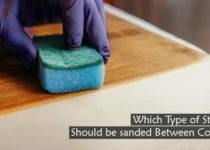How to Seal Flagstone Around Pool
Your summertime fun must include swimming with your family and friends along with other activities. So, your swimming pool always remains the most delightful place only when it is clean and well decorated. Hence, to decorate your pool and maintain hygiene you need to seal your pool coping. It is a natural stone that enhances the beauty of your pool only when you know how to seal flagstone around pool.

Unnecessary to say, swimming pools require higher maintenance. However, maintaining them is not as fun as swimming in them. While the water inside the pool needs to be maintained with quality, the ledge surrounding it also requires proper sealing. As the pool coping is exposed to water, chemicals, sun, cold, and other elements, the sealing should be protective enough.
So, stick with us to know everything about sealing flagstone around the pool.
Table of Contents:=>
Why Does Flagstone Need to be Sealed?
Well, there are many popular options for this task other than flagstones, such as limestone, travertine, Austin stone, quartzite, brick, and all. But flagstone comes with versatile benefits and it is beautiful. Years ago, people used to go for concrete and brick materials but now, flagstone is the modern solution for your pool coping.
However, none of the materials will remain resilient or invulnerable as long as the sealant is not applied. Again, like some of the other materials flagstone is also porous. Hence, only a sealer can fill in the pores and offer the best result. Filling the pores in the stone, a sealant resists spills and provides an excellent finish. Also, it protects your flagstone pool coping from salt water and chlorine damage.
Whatever you say, pool coping, deck, caps, or pillars that are made of flagstone are relentlessly manifested to water, harsh chemicals, foot traffic, and all. Thus, it is always better to go with the professional-grade sealant to make the surface serve you longer. There are sealants like the TSSPRO-100 that can create a waterproof barrier. They are also saltwater-proof and resistant to chlorine damage.
Again, once your flagstone around the pool is done with sealant, you can easily clean and maintain them. If it is sealed properly, the flagstone will never be able to absorb any harsh chemicals or acidic liquid if falls accidentally. So, whether it is pool decking or other flagstone patios, flooring, or tiles, the material always should be sealed.
2 Types of Flagstone Sealers to Get a Natural Look:
Before you go for the ways of sealing flagstone know that there are basically two types of sealers available.
#1. Penetrating Sealers:

These types of sealers mainly soak into the surface delivering a natural look of the flagstone. While flagstone is subjected to stains in pool areas that contain minerals and alkaline in the water, the penetrating sealer repels it. A penetrating sealer offers a matte finish of the flagstone and typically, this is more approved.
Read Also: 9 Best Sealer for Flagstone Around Pool [outdoor& Indoor]
Also, while still shedding water, the penetrating sealers can keep the natural properties and appearance of the stone.
#2. Film Forming Sealers:
Unlike penetrating sealers, film-forming sealers form a special layer, film, or coating on the surface of the flagstone. The film on the surface holds out the pool water and any kinds of stains. However, the film sealers tend to affect the natural look of the flagstone by adding a glossy look or color enhancement.
So, even though both matte and glossy sealants provide protection from staining and moisture yet, film sealers are unwise to use.
Now that you know the types of sealers it is easier for you to know which one to go for. Next, let’s get to the steps to seal the flagstone around the pool.
Must Read: 6 Best Concrete Stain for Pool Deck & Driveways, Patio.
4 Easy Steps to Seal Flagstone Around Pool:
Step-1: Pre-Sealing:

Though pre-sealing is the first step yet it can be done only when it is needed. You can apply roughly one or two coats of sealer as a grout release. Before grouting, grout release becomes important to get the perfect result. There are many fine sealers available for grouting release purposes.
Then let the seal be dried for 24 hours or more before getting to the next step.
Step-2: Grout:
This is the second step and is considered very important. Hence, you gotta do it right. It is always better if you take directions from the grout manufacturers. However, grout is done to minimize the water contact on the flagstone as much as possible.
Additionally, make sure the flagstone is cleaned well and it is also dried properly before getting to start sealing. If needed wait for at least one day.
Step-3: Process of Sealing:
 Among every step, this is the most crucial step. Carefulness and skilled hands are needed for the completion of the step. Listen carefully,
Among every step, this is the most crucial step. Carefulness and skilled hands are needed for the completion of the step. Listen carefully,
- First, apply your chosen sealer to the flagstone and grout that you have cleaned up and dried before.
- Now, if you have selected a penetrating type of sealer then apply a generous coat. After applying the sealant dry it duly within hours. When it finally gets dry you can apply a second coating if your flagstone permits.
- Then again, if you have gone for the film-forming type of sealer then you have to apply at least two or more evenly thin coats. Make sure you get the sealer dry between each coating. It will take from one to three hours for each coat to be dried properly. However, it all depends on the individual sealer label directions hence try to follow them.
- When the final coating is done, let the sealer dry all night long. Now you are done but try to minimize heavy traffic on the freshly sealed surface. It will take at least three days for the sealer to cure, set, and harden. Before that exposing the surface to contaminants, moisture, saltwater, and all is not a wise idea at all.
Step-4: Stain-Resistance Test:

This test is necessary before you get to polish the sealer. For this test, you can sprinkle water or some cooking oil drops to areas where it seems a bit inexplicit or inconspicuous. If you notice the oil or water darkens the flagstone then the additional sealant is needed again.
So, these are steps and ways to seal flagstone around the pool. However, if the flagstone is done indoors, it would have required polishing as the last step especially when the sealer is film-forming type.
Maintenance of Sealed Flagstone:
If you want your sealed flagstone around the pool to serve you long beyond your expectations then make sure it’s proper maintenance. However, once the flagstone is sealed, it won’t require high maintenance. Just follow some tips given below.
- Keep sweeping away any harsh substances, rocks, and debris frequently.
- Use any kind of broom to wipe away around the pool at least once a week.
- If the flagstone gets in touch with any rough acidic material sweep it instantly before it creates any reaction with the material.
- Use cleaners that are specially developed for flagstone material.
- If any chemicals or acids are used for cleaning purposes make sure to rinse off as soon as possible. you can use a concrete cleaner with a pressure washer for better performance.
Should I seal my pool coping?
Answer: Sealing pool coping is the smartest idea a homeowner can take. For the easy and quick maintenance of the pool, this job should be done. If your pool coping is made of flagstone, slate, or travertine, sealing them will make them more durable and beautiful to look at.
Also, pool coping with sealant primarily works as a safety precaution. It becomes resistant to slip hence swimmers can have it without scraping or scratching. So, if you want your pool coping made of natural stones to look at their best you should seal it. Also, to achieve optimal longevity of the pool coping protecting it from harsh chemicals or acidic substances, sealing should be done.
FAQ:
Question: What is the best stone sealer for saltwater pools?
Answer: To save your pool stone tiles from stains and damage, they need to be sealed properly. Hence, you need to go for the best stone sealers. However, each stone sealer has its own limitations and offerings to protect and preserve the stone. The best stone sealers for seal water pools have smaller molecular structures.
Unfortunately, not all the sealers in the market are the best. But some of them are worth trying as they are high-performing. The best sealers are quite effective and most importantly, they provide long-lasting protection to the saltwater pools. Preventing mold and mildew growth, the best sealer also resists the deterioration of pools from calcium deposits. Nonetheless, all of these best sealers are water-based and improved for protecting saltwater pools.
Question: Does sealing flagstone keep it from flaking?
Answer: We know that flagstone and any other natural stone tend to flaking and chipping. Again, some materials like quartzite and other elements that are used for flagstones are impervious to water damage. Hence, sealing it is the best possible solution for the flagstone from flaking and chipping.
Sealing the flagstone will resist the moisture on the surface from soaking. Hence, it will strongly hold up the bonds between the layers. Unfortunately, even the best quality sealers are not able to keep flagstone from flaking a hundred percent. However, they can reduce flaking substantially.
Conclusion:
Many brands offer quality stone sealers for saltwater pools. One of the brands is AquaMix. The AquaMix Sealers Choice and Ultra Solv both are considered the best sealers for stone. Also, the Dupont Grout Sealer and the Premium Stone Sealer are good options. Again, the Stonetech Impregnator and Stonetech Bulletproof stone sealers are also high-performing.
Now you can decide what types of sealer you should use to Seal Flagstone Around the pool or pool coping. Sealers play an important role to last longer than the flagstone pool coping surface, and it also prevents salt water and chlorine damage. Regular cleaning is also an important part of taking care of the flagstone pool coping.
Last Updated on July 1, 2024 by Rogers Weber
[As an Amazon Associate I earn from qualifying purchases.]


